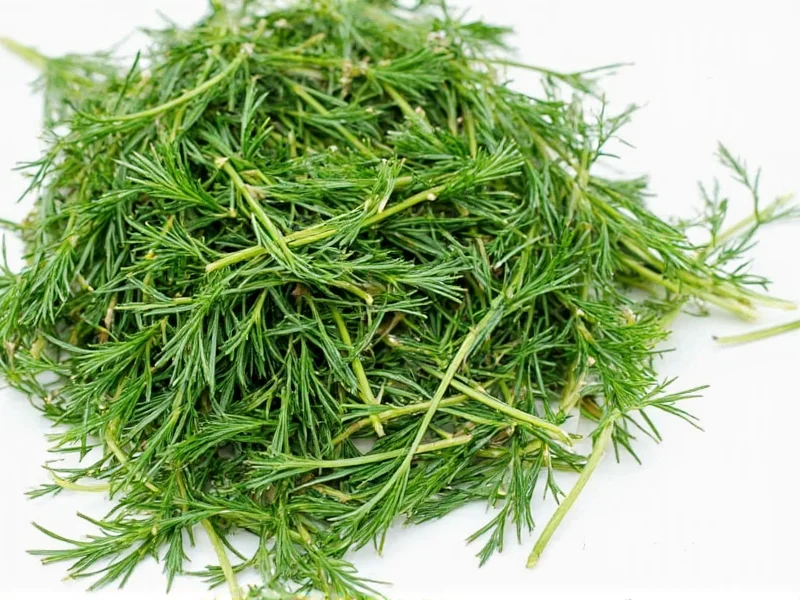When substituting fresh dill for dried in recipes, understanding the proper conversion ratio ensures your dishes maintain the intended flavor profile. Many home cooks struggle with herb substitutions, leading to under-seasoned or overpowering results. This guide provides precise measurements and practical tips for converting between fresh and dried dill.
Why the 3:1 Fresh Dill to Dried Conversion Ratio Matters
Dill loses approximately 80-90% of its water content when dried, significantly concentrating its essential oils and flavor compounds. Fresh dill contains moisture that dilutes its potency, while dried dill packs more intense flavor into a smaller volume. This scientific principle behind herb drying explains why you need three times the amount of fresh dill to match the flavor impact of dried dill.
Understanding fresh dill equivalent to dried dill measurements prevents common cooking mistakes. Using equal amounts of fresh dill when a recipe calls for dried will result in noticeably weaker flavor, while substituting dried dill for fresh without adjusting quantities can make dishes taste medicinal or overpowering.
Complete Fresh Dill to Dried Conversion Chart
| Fresh Dill | Dried Dill | Best For |
|---|---|---|
| 1 teaspoon | ⅓ teaspoon | Small batch dressings|
| 1 tablespoon | 1 teaspoon | Standard recipe measurements|
| ¼ cup | 1¼ tablespoons | Pickling recipes|
| ½ cup | 2½ tablespoons | Large batch cooking|
| 1 cup | 5 tablespoons (⅓ cup) | Commercial food preparation
Practical Substitution Tips for Cooking
When working with fresh dill substitution for dried dill in your recipes, consider these professional tips:
- Add fresh dill later in the cooking process than dried dill, as its delicate flavor dissipates with prolonged heat exposure
- For cold dishes like salads or dips, use 25% more fresh dill than the conversion chart suggests, as cold temperatures mute flavors
- When making pickles, use the full 3:1 ratio as the vinegar solution extracts flavor more efficiently from fresh dill
- For baking applications, dried dill works better as fresh dill's moisture can affect dough consistency
How to Properly Dry Fresh Dill at Home
If you're looking to convert fresh dill to dried dill for long-term storage, follow these professional methods:
Air Drying Method (Best Flavor Preservation)
Gather fresh dill sprigs into small bundles (¼ inch diameter), secure with twine, and hang upside down in a dark, warm, well-ventilated area with 40-50% humidity. Complete drying takes 1-2 weeks. The dill is ready when leaves crumble easily between fingers.
Dehydrator Method (Fastest Results)
Place dill sprigs in a single layer on dehydrator trays. Dry at 95°F (35°C) for 4-8 hours, checking periodically. Lower temperatures preserve more essential oils and flavor compounds.
Oven Drying Method (Emergency Option)
Spread dill on a baking sheet and place in oven with light on only (no heat) for 8-12 hours. Alternatively, use the lowest possible temperature setting (170°F/75°C) with oven door slightly ajar for 2-3 hours. This method risks flavor loss from heat exposure.
Storing Your Dried Dill Properly
After converting fresh dill to dried dill, proper storage maintains quality:
- Crumble leaves from stems completely before storage
- Use airtight glass containers rather than plastic (which can impart flavors)
- Store in a cool, dark place away from heat sources
- Label containers with drying date (peak flavor lasts 6-12 months)
- Freeze for long-term storage (up to 2 years) in vacuum-sealed bags
Fresh vs. Dried Dill: When to Use Each
Understanding which form works best for specific applications improves your cooking results:
- Use fresh dill when: Making tzatziki, Scandinavian gravlax, fresh salads, or as a garnish where visual appeal matters
- Use dried dill when: Preparing soups, stews, pickling brines, or spice rubs where prolonged cooking extracts maximum flavor
- Never substitute when: Making dill butter or fresh herb sauces where texture and moisture content are critical
Common Fresh to Dried Dill Conversion Mistakes
Avoid these frequent errors when measuring fresh dill to dried conversion:
- Using volume measurements for both without accounting for density differences
- Not adjusting for dill's age (older fresh dill has less potency)
- Storing dried dill in clear containers that degrade flavor with light exposure
- Using the same conversion ratio for all cooking applications without considering dish temperature
- Not tasting as you go when substituting, especially with delicate dishes
Testing Your Dill's Potency
Before making fresh dill to dried dill substitution, test your herbs' strength:
- Crush a small amount of dried dill between your fingers
- Smell immediately - strong, clean aroma indicates good quality
- For fresh dill, rub a leaf between fingers and check for vibrant green color transfer
- If aroma is weak or musty, increase your measurement by 25-50%











 浙公网安备
33010002000092号
浙公网安备
33010002000092号 浙B2-20120091-4
浙B2-20120091-4